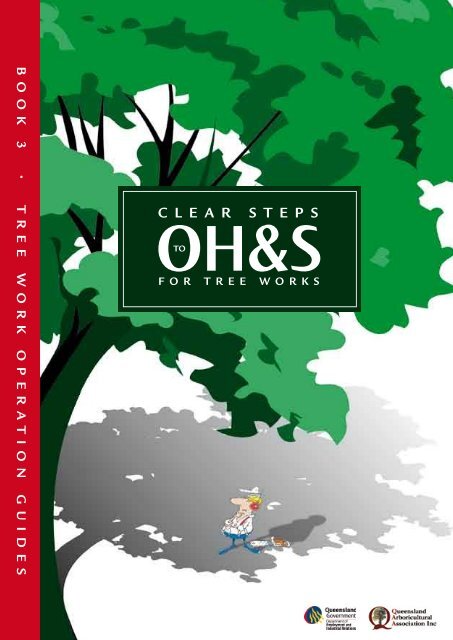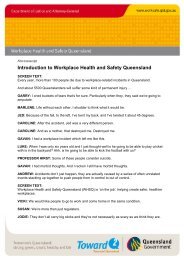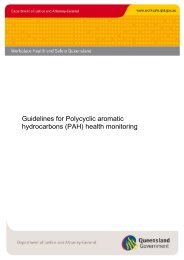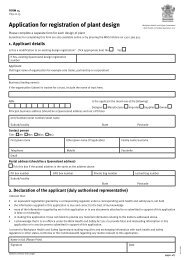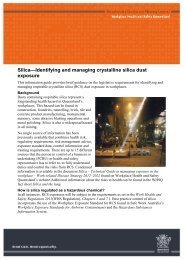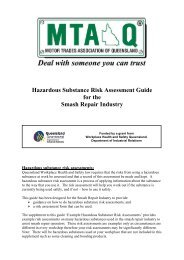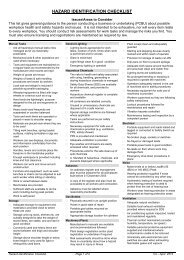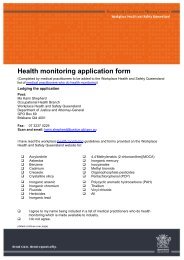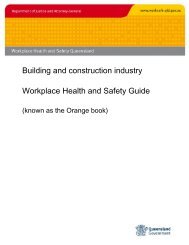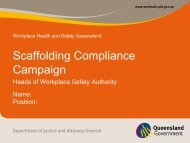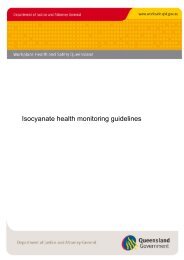Tree work operation guides
Tree work operation guides
Tree work operation guides
You also want an ePaper? Increase the reach of your titles
YUMPU automatically turns print PDFs into web optimized ePapers that Google loves.
B O O K 3 • T R E E W O R K O P E R A T I O N G U I D E S<br />
C L E A R S T E P S<br />
OH&S<br />
TO<br />
F O R T R E E W O R K S
T R E E W O R K O P E R A T I O N G U I D E S<br />
Contents<br />
Book 3 <strong>Tree</strong> Work Operation Guides<br />
CHAPTER<br />
PAGE<br />
Operational <strong>Tree</strong> Work Guides 3<br />
Self Assessment Check List for Operations 4<br />
Assessing the <strong>Tree</strong> 5<br />
Preparing and Assessing Your Work Site 6<br />
Climbing, Rigging and Working with Ladders 8<br />
Emergency Procedures and Aerial Rescue 10<br />
What to do in an Emergency 12<br />
Incident Report Form 13<br />
Common Hazards of Outdoor Work 14<br />
Working Near Power Lines 16<br />
Manual Handling 17<br />
Vehicle and Pedestrian Traffic Management 18<br />
Useful Contacts Guide 19<br />
DISCLAIMER: The information contained within the elements of this kit is for guidance only and is not intended as a substitute for training.<br />
It should not be taken as an expression of the law, or specific direction in relation to fulfilling your obligations under the law. It should be read<br />
in conjunction with the Workplace Health and Safety Act 1995, the Workplace Health and Safety Regulations 1997 and any other relevant<br />
legislation applicable to your individual <strong>work</strong>places.<br />
Whilst care has been taken in providing you this information, the Queensland Arboricultural Association, Workplace Health and Safety<br />
Queensland, their employees, advisors and agents will not be liable for any errors or omissions, or for any loss or damage suffered by you or<br />
any person which arises (directly or indirectly) from your reliance on information contained within this kit, or any breaches by you of your<br />
obligations under the Act.<br />
All information supplied within this kit is given on the basis that you will make your own independent assessment of what action is necessary<br />
to ensure your compliance with the Act.<br />
Proudly produced and distributed by the Queensland Arboricultural Association<br />
Funded by Workplace Health and Safety Queensland Department of Employment and Industrial Relations 2007<br />
With design, production and assistance provided by ArborSafe Australia Pty Ltd. Tel: 03 9589 4986<br />
2
T R E E W O R K O P E R A T I O N G U I D E S<br />
Introduction to Book 3<br />
The following sections provide an overview on <strong>operation</strong>al tree <strong>work</strong> and offer you some practical<br />
<strong>guides</strong> to assist in not only the safe <strong>operation</strong>s of your tree business but also provide some starter<br />
tools and information that can make your <strong>operation</strong>s safer and more eficient.<br />
For more detailed publications on <strong>operation</strong>al guidelines, contact the QAA for a copy of<br />
Arboricultural Safety Guidelines. This publication provides more detail on each aspect of tree <strong>work</strong><br />
<strong>operation</strong>s and expands upon the starter information provided within this kit.<br />
Operational <strong>Tree</strong> Work Guides<br />
How many times have you experienced signiicant down time because someone didn’t consider<br />
a particular aspect of the job?! Often what seems eficient to <strong>work</strong>ers or crew leaders “charging<br />
straight into the job” actually results in ineficient, or unsafe practices throughout the task.<br />
By contrast, a small amount of time spent assessing the job and the surrounding aspects can result in<br />
faster <strong>operation</strong>s, safer <strong>work</strong>places, less down time, better <strong>work</strong> standards, clearer training, better job<br />
satisfaction from <strong>work</strong>ers and most importantly, happier clients - prepared to call you again, or even<br />
pay a premium because you offer better <strong>work</strong> standards.<br />
Topics covered in this guide include:<br />
Assessing the <strong>Tree</strong><br />
<strong>Tree</strong> Work Hazard Check List<br />
Working Near Power Lines<br />
Preparing Your Work Site<br />
Climbing, Rigging and Working with Ladders<br />
Emergency Procedures and Aerial Rescue<br />
Common Hazards of Outdoor Work<br />
Manual Handling<br />
Vehicle and Pedestrian Trafic Management<br />
3
T R E E W O R K O P E R A T I O N G U I D E S<br />
Self Assessment Check List for Operations<br />
Use the following check list ONCE as a guide to the hazards present in your typical <strong>work</strong> site.<br />
For any “Partial” or “No” responses check you have performed a Hazard Assessment for these Items<br />
or Activities and ensure you implement the associated Control Measures. For any items that you have<br />
not performed a Hazard Assessment on, refer to Steps 2 & 3 and relevant forms within this kit.<br />
SITE ASSESSMENT<br />
Do you assess each site for safety of people and protection of property?<br />
Is each site assessed for overhead and underground services such as electricity?<br />
Are staff aware of the exclusion zones to high and low voltage transmission lines?<br />
Is the correct certification held by <strong>work</strong>ers <strong>work</strong>ing near electrical transmission lines?<br />
Do you assess each tree being <strong>work</strong>ed on for safety issues prior to climbing, EWP or ground <strong>work</strong>?<br />
Are staff trained in emergency procedures with site variations discussed prior to <strong>work</strong> on each site?<br />
Are safety items at every site (e.g. first aid, extinguishers, sunscreen, water, spare PPE & comms)?<br />
Have staff at every site had adequate safety training (inc. first aid and aerial rescue)?<br />
Do <strong>work</strong>ers clean up the site as they go to reduce trip hazards?<br />
If ladders are used are they rated for the loads carried, always inspected and secured prior to use?<br />
Do you have (and enforce) control measures at every site to exclude public access to the <strong>work</strong> areas?<br />
Do you use appropriate signage and traffic management for vehicles and pedestrians at every site?<br />
Is debris removed from all pedestrian areas prior to departing each site?<br />
PLANT, TOOLS AND EQUIPMENT (INCLUDING CLIMBING EQUIP)<br />
Are all plant, tools and equipment checked prior to commencing <strong>work</strong> at each site?<br />
Are all plant, tools and equipment checked to ensure it is rated to the tasks at each site?<br />
Do staff using plant, tools and equipment at every site have correct certification and training?<br />
Are exclusion zones around plant, equipment and <strong>operation</strong>s maintained at every site?<br />
Have you implemented control measures for plant and equipment noise at every site?<br />
Has training been implemented to ensure commands can be communicated in noisy environments?<br />
DANGEROUS GOODS & HAZARDOUS SUBSTANCES (DG&HS)<br />
Are all DG&HS used at each site in proper receptacles with adequate labelling?<br />
Do you have material safety data sheets (MSDS’s) on-site for DG&HS used at each site?<br />
Are staff at every site trained in the safety requirements of all DG&HS present at each site?<br />
Are control measures for DG&HS present (e.g. appropriate fire extinguishers and spill kits)?<br />
WORKERS PHYSICAL STRESS AND THE ENVIRONMENT<br />
Do you assess environmental factors at every site such as heat, cold, wind and rain?<br />
Are all tasks assessed to ensure they are within the physical capacity of <strong>work</strong>ers?<br />
Do you ensure regular breaks for <strong>work</strong>ers exposed to noise, vibration, dust, heat and cold?<br />
Do you ensure debris is cut into small pieces when manual handling?<br />
Are <strong>work</strong>ers promoted to rotate tasks to minimise physical stress and fatigue?<br />
YES PARTIAL NO<br />
YES PARTIAL NO<br />
YES PARTIAL NO<br />
YES PARTIAL NO<br />
Each tick in the Yes Zone means you are likely to assess these elements. Ensure you document assessments.<br />
Each tick in the Partial Zone means you need to review your Hazard Assessment of these elements and controls that apply.<br />
Each tick in the No Zone means you need to perform Hazard Assessments on these elements and implement Control Measures.<br />
4
T R E E W O R K O P E R A T I O N G U I D E S<br />
Assessing the <strong>Tree</strong><br />
Before undertaking any tree <strong>work</strong>, take time to assess and understand the different characteristics<br />
of the tree along with any special considerations based on species (allergens, thorns, etc.).<br />
Climbers, or EWP operators, must also be able to recognise potential weakness caused by decay,<br />
damage or poor structure of the tree. Climbers, or EWP operators, not speciically trained in utility<br />
<strong>work</strong> (<strong>work</strong>ing near power lines) must observe the appropriate minimum distances for <strong>work</strong> adjacent<br />
to overhead power lines (see your local utilities guide for limits of approach).<br />
The diagram below is a guide to on site tree assessment. There is also a Job Site Assessment Checklist<br />
form on page 7 – you may use these as a basis for developing your own tree and site assessment form.<br />
On-site <strong>Tree</strong> Assessment<br />
Is the crown leaning heavily?<br />
Are there vines or creepers in the crown?<br />
Is the crown concealing nests or insect colonies?<br />
Are branches intruding from other trees nearby?<br />
Are there any dead or diseased branches?<br />
Are any nails, wire or spikes embedded in the tree?<br />
Is the tree exhibiting signs of internal cavities within it?<br />
Is the tree stable in the ground, splits or visual decay in the trunk?<br />
What are the limb stengths and suitability for climbing & rigging?<br />
What is the tree species and special considerations needed?<br />
Is there a safer way of performing the <strong>work</strong> without climbing?<br />
Has the safest <strong>work</strong> method been selected?<br />
Has the <strong>work</strong> method been discussed with <strong>work</strong>ers?<br />
From your assessment, action plans should be formed. Make sure all <strong>work</strong>ers involved in any<br />
<strong>operation</strong> on the <strong>work</strong> site are made aware of potential hazards and how they are to be controlled.<br />
*Tip: Don’t forget to look at all aspects of the surrounding environment - not just the tree.<br />
Work should not commence until you have assessed ALL the potential hazards and risks and implemented safety<br />
Control Measures.<br />
5
T R E E W O R K O P E R A T I O N G U I D E S<br />
Preparing and Assessing Your Work Site<br />
There are a number of things that must be considered for each job. Use the checklists below as a basis<br />
for developing your own job checklists. Opposite (and on CD) is a simple Job Site Assessment (JSA)<br />
and Checklist which you can use or amend to suit your <strong>operation</strong>s. Also on CD are further <strong>work</strong>place<br />
and safety <strong>guides</strong> by WHSQ that can be used as a basis for making your own assessment forms.<br />
Your checklists should cover your typical <strong>operation</strong>s, staff and equipment and will help ensure all safety<br />
and <strong>operation</strong>al aspects of the job have been considered. It should also improve eficiency and reduce<br />
downtime from mistakes as all site requirements will be considered by <strong>work</strong>ers.<br />
Brief Checklist - Prior to Leaving the Yard (Give further consideration to any boxes ticked)<br />
Does the job only require ground <strong>work</strong>?<br />
Does the job require climbing?<br />
Have climbers and crew been trained in emergency procedures?<br />
Does the job require an elevating <strong>work</strong> platform (EWP) or can an EWP be used instead of climbing?<br />
Does the job require specialist rigging gear?<br />
Have operators and crew been trained in emergency procedures?<br />
Do relevant authorities (e.g. power company, local government) need to be notiied?<br />
Are relevant permits, certiication and licences held and accounted for?<br />
Is the correct equipment and staff allocated to the job?<br />
Is all equipment in good <strong>work</strong>ing order and all checked prior to departure?<br />
Are all staff it for <strong>work</strong>?<br />
Are all staff trained and capable for the tasks allocated to them?<br />
Brief Checklist - At the Site, Prior to Commencing Work<br />
All Hazards have been assessed on-site.<br />
Action plans have been discussed with all crew members in relation to hazards.<br />
<strong>Tree</strong>s have been inspected for conditions or situations that could pose a risk.<br />
The path of the tree’s fall, debris fall and all impact points have been assessed.<br />
Potential for damage to buildings, equipment and vehicles have been assessed and managed.<br />
Potential weather issues have been considered (wind, heat, cold, rain) and discussed with crew.<br />
Equipment has been placed to minimise risk to crew and the public.<br />
Appropriate signage, manned or taped off areas (exclusion zones) are in place.<br />
Final gear check performed to ensure good <strong>work</strong>ing order.<br />
Emergency procedures have been evaluated in relation to the site and crew are trained.<br />
Communication to base and emergency services is available with adequate signal.<br />
Work should not commence until you have assessed all potential hazards and risks and implemented safety<br />
Control Measures.<br />
6
JOB SITE ASSESSMENT (JSA) AND CHECKLIST<br />
SITE<br />
JOB/QUOTE NO.<br />
CREW PRESENT<br />
PERFORMED BY<br />
CREW UNDERSTAND & INITIAL<br />
SITE MANAGER/SUPERVISOR<br />
SIGNATURE<br />
START DATE<br />
DATE<br />
HAZARD SUB-HAZARD CONTROL MEASURES<br />
ON-SITE<br />
OVERHEAD POWERLINES<br />
ELECTRICAL LINE TO PROPERTY<br />
TELEPHONE AND CABLE LINES<br />
STAFF ARE TRAINED<br />
REGULATION DISTANCES<br />
APPROPRIATE EQUIPMENT<br />
UNDERSTOOD BY ALL<br />
PRESENT AND CHECKED<br />
UNDERGROUND SERVICES (INC. WATER) ACCURATE DETECTION UNDERSTOOD BY ALL<br />
VEHICLE & PEDESTRIAN TRAFFIC<br />
SIGNS, CONES ETC.<br />
EXCLUSION ZONES<br />
STAFF ALLOCATED<br />
IN PLACE<br />
CHECKED & ENFORCEMENT PRESENT<br />
TRAINED & UNDERSTAND REQUIREMENTS<br />
WEATHER<br />
TREE<br />
(also refer to<br />
tree assessment)<br />
EQUIPMENT<br />
MACHINERY<br />
STAFF<br />
BUILDINGS & ASSETS<br />
TERRAIN AND ACCESS<br />
HEAT/COLD/WIND/WET<br />
UNSTABLE / SPLITS / DECAY / NAILS, WIRE, SPIKES /<br />
DEAD, DISEASED BRANCHES / VINES / NESTS /<br />
INSECT COLONIES / CROWN LEANING HEAVILY /<br />
BRANCHES INTRUDING FROM OTHER TREES /<br />
ROPES, HARNESS AND POLE BELTS<br />
SAWS<br />
SAFETY EQUIPMENT, FIRST AID AND PPE<br />
WOOD CHIPPERS<br />
STUMP GRINDERS<br />
ELEVATED WORK PLATFORMS (EWP)<br />
CRANES<br />
DINGO/BOBCAT/EXCAVATOR<br />
TRAINING<br />
QUANTITY<br />
TASK ALLOCATION<br />
SAFE WORKING DISTANCES. TRAINED AND UNDERSTOOD<br />
APPROPRIATE EQUIPMENT & LOCATION<br />
CHECKED<br />
MODIFY WORK PRACTICES. TRAINED AND UNDERSTOOD<br />
WEATHER PROTECTION GEAR (INC. SUNSCREEN) ISSUED<br />
THOROUGH INSPECTION PERFORMED<br />
APPROPRIATE ACCESS METHODS CHOSEN<br />
TRAINED AND UNDERSTAND CONTROL MEASURES<br />
FALL PATH ASSESSED<br />
CHECKED FOR WEAR, DAMAGE AND SAFETY<br />
CHAIN BRAKES, TENSION AND SHARPNESS<br />
SIZE CORRECT FOR JOB<br />
TRAINED OPERATORS<br />
ADEQUATE NUMBER<br />
APPROPRIATE LOCATION RELATIVE TO USE AND TRAINED STAFF<br />
PRESENT AND CHECKED<br />
AERIAL RESCUE GEAR PRESENT, CHECKED AND STAFF TRAINED<br />
STAFF TRAINED<br />
SAFETY SIGNS AND EXCLUSION ZONES<br />
GUARDS, SHUTES AND EMERGENCY CONTROLS CHECKED<br />
SIZE APPROPRIATE FOR JOB<br />
BLADES SHARP AND WELL FASTENED<br />
RATED FOR LOADS<br />
LICENSED OPERATORS INC. SPOTTERS/DOGMEN PRESENT<br />
SAFETY SIGNS AND EXCLUSION ZONES<br />
EMERGENCY CONTROLS, SERVICE & MAINTENANCE CHECKED<br />
CORRECT SIZE FOR TASK<br />
LICENSED OPERATORS PRESENT<br />
SAFETY SIGNS AND EXCLUSION ZONES<br />
EMERGENCY CONTROLS, SERVICE & MAINTENANCE CHECKED<br />
TRAINED AND UNDERSTAND CONTROL MEASURES<br />
SUFFICIENT FOR SAFE OPERATION<br />
ISSUED, CLEAR AND UNDERSTOOD BY ALL<br />
7
T R E E W O R K O P E R A T I O N G U I D E S<br />
Climbing, Rigging and Working with Ladders<br />
You should always assess the safest method of <strong>operation</strong> for any tree <strong>work</strong>. At each site<br />
consideration should be given as to whether climbing is necessary. Or can the <strong>work</strong> be performed<br />
with an EWP, or from the ground?<br />
If it is decided that climbing is the most appropriate method for the <strong>work</strong>s required, ensure the<br />
climber is appropriately skilled, it and competent and the procedures followed by people on the<br />
ground account for all aspects of safety including the potential need to conduct an aerial rescue.<br />
Climbers should NEVER <strong>work</strong> alone.<br />
Generally there should only be one climber in a tree at any one time. However, if two climbers are<br />
required, one should be senior and well experienced. You should ensure good communication<br />
between the climbers at all times so that each is aware of the other’s position while <strong>work</strong> progresses.<br />
They should <strong>work</strong> at about the same height in the tree and remain in sight of each other.<br />
Climbers should NEVER <strong>work</strong> directly above each other.<br />
*Tips - for Climbing and Rigging:<br />
• Only use equipment rated and/or assembled by rated agencies.<br />
• Check entire length of climbing ropes, lanyards, harness and karabiners for cuts, excessive wear<br />
and correct function prior to EACH climb.<br />
• Wear PPE in accordance with manufacturers’ speciications and your Hazard Control Measures.<br />
• Remove all jewellery and tie up long hair before climbing.<br />
• Ensure a second experienced climber is available and is trained in irst aid and aerial rescue.<br />
• Ensure that a second set of climbing gear has been checked and is available for rescue purposes.<br />
• Stay attached to the tree at all times from a high, secure tie-in point with a secondary anchor point.<br />
• When changing anchor points, climbers should transfer their weight to the new rope system before<br />
releasing the original anchor.<br />
• Test any limbs you are unsure of prior to weight bearing.<br />
• Ensure your anchor points, equipment and people are clear of drop zones for debris.<br />
• Keep the climbing system as taut as possible and re-route the rope as required to keep it clear.<br />
• Move through the tree and back to the ground with smooth, controlled movement.<br />
*Tips - for use of Ladders:<br />
• Ladders must provide adequate height and base grip and be checked for defects before use.<br />
• Ladders are normally only used as a means of access into the crown of the tree. Once the climber<br />
is secured to the tree by rope/strop and harness, the ladder should be removed.<br />
• Do not over-extend the overlap between sections of an extension ladder beyond the manufacturer’s<br />
speciications. If in doubt, a minimum overlap of three rungs should be used.<br />
• The ladder should be set irmly and secured to prevent movement, stabilised throughout use by a<br />
member of the ground staff by holding the ladder and footing the base, or by lashing it to the tree.<br />
8
T R E E W O R K O P E R A T I O N G U I D E S<br />
• The base should be positioned out from the trunk approx one quarter of its height up the tree.<br />
• When using a ladder for ascent into a tree, the climber must be secured to the tree before leaving<br />
the top of the ladder or carrying out any <strong>work</strong>.<br />
• When not in use, remove ladders and store them out of the <strong>work</strong> zone.<br />
*Tips - for Climbers’ use of Chainsaws:<br />
• Stabilise your position in the tree before cutting.<br />
• Ensure that you have a second point of attachment.<br />
• Wherever possible, hold any chainsaw with both hands.<br />
• Wherever possible, operate the chainsaw only below shoulder level.<br />
• Always apply the chain brake when leaving the saw running.<br />
*Tips - for Communication:<br />
• Climbers and ground crew should stay in constant communication via both sight and sound.<br />
• Ground crew must maintain an exclusion zone throughout the <strong>work</strong>s.<br />
• Climbers and ground crew must monitor any exclusion zones.<br />
• All <strong>work</strong> must stop if other people (or animals) enter the <strong>work</strong> area.<br />
Before Each Climb - Visually Inspect All Equipment<br />
F O R E X A M P L E<br />
ROPE CHECK<br />
CUTS<br />
BULGING<br />
NARROWING<br />
CONTAMINATION<br />
(OIL, FUEL CHEMICALS)<br />
EXCESSIVE FRAYING<br />
If any defects are found replace the item prior to climbing<br />
Remember to destroy or dispose of any defective equipment to prevent further use<br />
9
T R E E W O R K O P E R A T I O N G U I D E S<br />
Emergency Procedures and Aerial Rescue<br />
There are many incidents and situations in tree <strong>work</strong> that could require emergency action. Therefore<br />
it is vital that you develop and train staff in your own emergency procedures. All crew members must<br />
be familiar with emergency procedures. Rescue and irst aid training must form an integral part of<br />
your induction programme for all <strong>work</strong>ers. Workers must know these procedures from day one.<br />
Everyone involved in aerial tree rescue must have the appropriate training in all the tasks required.<br />
A rescuer’s safety takes priority at all times. It is strongly recommended that climbing teams regularly<br />
practise rescue techniques.<br />
Aerial Rescue requirements<br />
• A ground crew member needs to be available, trained and equipped to perform an aerial rescue<br />
on every site where climbing takes place.<br />
• Ensure adequate communication equipment and signal is available on every site.<br />
• Evaluate emergency procedures as part of your site assessment. Ensure all staff on site have received<br />
adequate instruction, information and training in these procedures.<br />
• When an injured climber needs rescuing, ensure all possible precautions are taken to safeguard<br />
other members of the <strong>work</strong> team, as well as any others entering or approaching the <strong>work</strong> site.<br />
If overhead cables are involved, do not approach the <strong>work</strong> area. Stop <strong>work</strong>, assess the situation and contact<br />
the relevant electricity company.<br />
• The casualty’s condition must be assessed. If necessary, call for the emergency services (Tel 000)<br />
before starting the rescue, ensuring appropriate information is given regarding the exact location<br />
of the site and any particular access problems, treatment given and other information of relevance.<br />
• Send for any additional rescue equipment that becomes necessary. If appropriate, other people<br />
in the vicinity may be directed to provide help or items required.<br />
Rescue equipment<br />
• A suitable irst-aid kit.<br />
• A suitable climber’s harness and associated equipment.<br />
• Other items of equipment that can be of assistance include: a ladder, climbing irons, ascenders<br />
or decenders, a sharp knife with a retractable blade.<br />
• A form of communication that functions on-site (i.e. mobile phone with signal).<br />
• A whistle or horn are good tools to attract attention in an emergency.<br />
Helping the casualty<br />
• Reassure the casualty and encourage self-help if possible.<br />
• Select a rescue method which does not put the rescuer at risk and minimises the risk of further<br />
injury to the casualty.<br />
• Only trained operators should use equipment such as EWPs and cranes for an aerial tree rescue.<br />
10
T R E E W O R K O P E R A T I O N G U I D E S<br />
Rescuing the casualty<br />
• The casualty must be made safe from immediate hazards as soon as possible.<br />
• Reassure the casualty and maintain communication with them.<br />
• Secure or rig timber and/or remove objects that pose further hazards to the casualty.<br />
• Assess the casualty’s condition and determine irst-aid treatment requirements.<br />
• If required, call for the emergency services before starting the rescue, or delegate others to do so.<br />
• Select the safest and most eficient method of accessing the tree to reach the casualty.<br />
• Take account of hazards, such as broken, hanging branches or equipment that may pose risks<br />
for the rescuer, the casualty, ground crew and/or emergency services personnel.<br />
• If tree access is impeded, select appropriate equipment to remove parts of the tree. Other crew<br />
may be able to perform these and other functions to speed the rescue.<br />
• Rescuers must be properly anchored at all times to ensure their own safety throughout the rescue<br />
<strong>operation</strong>. Select anchor points capable of taking the anticipated loads during the rescue.<br />
• In some cases, especially those involving fracture, crush or possible spinal injury, only move<br />
the victim under medical supervision (eg. a paramedic or the ambulance oficer).<br />
• The rescuer should maintain close contact with the casualty to monitor changes in condition<br />
and to calm and control them if necessary.<br />
• When the casualty is brought down from the tree, the rescuer and casualty should descend together<br />
to ease movement through the branches and to monitor the casualty’s condition.<br />
• Densely branched trees may require alternative methods of rescue. Obstacles on the ground may<br />
dictate the most suitable method.<br />
• Continue to help the casualty under the direction of paramedics until the casualty is transported<br />
from the site.<br />
• Ensure the site is safe and secure before all personnel leave. Note the contact details of any<br />
witnesses. Where possible take photographs of the site. Do not use any of the equipment involved<br />
in the incident until it has been thoroughly examined by a competent person.<br />
• Notify management of the incident and record the occurrence in the incidents and accident register.<br />
• Report the incident to authorities and your Worker’s Compensation Insurer as appropriate.<br />
General emergency procedures for base and <strong>work</strong> sites<br />
• Ensure all staff are familiar with emergency evacuation procedures and assembly points.<br />
• Ensure all staff are familiar with the location and use of ire extinguishers and irst aid kits.<br />
• Ensure staff are trained in safety procedures for fuel and chemical spills.<br />
• Ensure all staff have training and access to communications equipment such as two-way radios<br />
and/or mobile phones.<br />
• Nominate a person in charge of safety at every site and make all staff aware of their roles.<br />
• Establish your own “evacuate” and “all-clear” call signs or signals for use by all staff.<br />
Note: Regular practice of your aerial rescue procedure is essential to ensure effectiveness.<br />
11
T R E E W O R K O P E R A T I O N G U I D E S<br />
What to do in an Emergency<br />
1. Dial 000 and ask for Ambulance. If it is a fatality, dial 000 and ask for Police. If a ire, dial<br />
000 and ask for the Fire Department. If overhead power lines have fallen down notify the<br />
relevant electricity company or Police.<br />
2. Administer irst aid if required. Do not touch anyone who is receiving an electric shock. Turn off<br />
power, or free the person with a non-metallic item. Nothing should be touched or moved unless<br />
it is to administer irst aid, or there is further risk of property damage.<br />
3. Contact Workplace Health and Safety Queensland on 1300 369 915. Workplace Health and<br />
Safety Queensland must be contacted if:<br />
- someone is killed<br />
- someone suffers serious bodily injury or illness<br />
- an incident occurs which could have resulted in death or serious injury or illness.<br />
Workplace Health and Safety Queensland can provide approval to touch the scene.<br />
An inspector, or police oficer may need to investigate the scene of a serious <strong>work</strong>place incident.<br />
Once the relevant authorities have been contacted and any assistance requests have been made the<br />
next action should be to continue to administer and monitor any irst aid requirements. Shut down<br />
and secure the site by clearing debris, as well as removing hazards such as partly felled trees or limbs.<br />
Ensure clear site access of emergency services. Turn off all plant and equipment. Direct staff to safety,<br />
or appoint them to emergency duties that they are capable of performing safely - based on their level<br />
of training.<br />
In the event of ire put your ire plan into action. Remember only use ire extinguishers or water hoses<br />
appropriate for the ire type (e.g. don’t use water on an electrical ire).<br />
In an incident involving Dangerous Goods & Hazardous Substances (DG&HS) refer to the Material<br />
Safety Data Sheet (MSDS) for the goods or substance that you should have with you on site. MSDS’s<br />
provide information on safety risks and how to manage them. Use this information to help control the<br />
incident.<br />
Vehicle and Pedestrian Trafic Management may need to be enacted or changed based on the incident<br />
or accident that has occurred. Ensure adequate trafic management is in place to secure the safety of<br />
the public or other <strong>work</strong>ers. Appoint trained <strong>work</strong>ers as trafic managers to police exclusion zones and<br />
direct all trafic, including emergency services and Workplace Health and Safety inspectors.<br />
Once the immediate emergency has passed make sure you secure the site before departure and ensure<br />
all your records about the site and the incident are present and up to date.<br />
Once back at base record the details of the event using the Incident Report Form opposite (and on<br />
CD) and attach any other details, forms or photos. Your Incident Report Form should document all<br />
aspects of the incident and outline actions you intend to take to reduce the risk of it happening again.<br />
12
INCIDENT REPORT FORM<br />
SITE<br />
JOB/QUOTE NO.<br />
CREW PRESENT<br />
REPORT BY<br />
CREW AGREE & INITIAL<br />
SITE MANAGER/SUPERVISOR<br />
SIGNATURE<br />
DATE<br />
DATE<br />
Workplace Health and Safety Queensland must be contacted if:<br />
1. Someone is killed. 2. Someone suffers serious bodily injury or illness. 3. An incident occurs which could have resulted in death or serious injury or illness.<br />
Workplace Health and Safety Queensland can provide approval to touch the scene. An inspector, or police officer may need to investigate the scene of a <strong>work</strong>place incident.<br />
Contact Workplace Health and Safety Queensland on 1300 369 915.<br />
WHAT HAPPENED?<br />
EVENT<br />
(WRITE ON THE OTHER SIDE OF THIS PAGE IF MORE SPACE IS REQUIRED)<br />
BRIEF DESCRIPTION OF WORK AND EVENT<br />
INJURY<br />
BRIEF DESCRIPTION OF INJURY<br />
REQUIRED ADMISSION TO HOSPITAL YES<br />
NO<br />
DAMAGE<br />
BRIEF DESCRIPTION OF PROPERTY OR ENVIRONMENTAL DAMAGE<br />
WHEN AND WHERE DID IT HAPPEN?<br />
DATE<br />
TIME<br />
WHO WAS EFFECTED?<br />
LOCATION (IF NOT SITE ADDRESS ABOVE)<br />
NAMES<br />
PHONE NO.<br />
POSITION<br />
WHO WAS A WITNESS?<br />
NAMES<br />
PHONE NO’s.<br />
WHAT WAS THE LIKELY CAUSE OF THE INCIDENT?<br />
BRIEF DESCRIPTION OF CAUSE<br />
WHAT WILL BE DONE TO ENSURE IT DOESN’T HAPPEN AGAIN?<br />
BRIEF DESCRIPTION OF REMEDIAL ACTION
T R E E W O R K O P E R A T I O N G U I D E S<br />
Common Hazards of Outdoor Work<br />
All outdoor <strong>operation</strong>s present a speciic range of hazards and risks. They may bring immediate<br />
or long term health consequences. They can also impact on the safety of <strong>work</strong> <strong>operation</strong>s, so<br />
understanding the hazards and risks is an important step in your safe <strong>work</strong>place.<br />
Some Common Outdoor Hazards include:<br />
• Environmental factors<br />
- Air temperature (from the environment as well as plant and equipment).<br />
- Air movement/wind speed/air circulation/wind chill.<br />
- Air moisture/rain/hail/humidity.<br />
- Air quality.<br />
- UV radiation.<br />
• Fatigue; physical and mental.<br />
• Insects, animals and allergies.<br />
These hazards act in combination and all effect the capacity of the <strong>work</strong>er to perform any task.<br />
The degree to which these factors will effect <strong>work</strong>ers at any given time should be assessed prior to<br />
commencing <strong>work</strong> and then regularly monitored throughout the duration of the job. To assess and<br />
manage these hazards use the following points as a guide.<br />
Managing Environmental Factors<br />
• Assess the risks from environmental conditions prior to, and during, the <strong>work</strong> activity and assess<br />
whether <strong>work</strong>ers can perform the required tasks safely.<br />
• Train <strong>work</strong>ers to be aware of and recognise the symptoms of heat and cold related illnesses.<br />
• Provide regular breaks and shelter from the elements.<br />
• Review <strong>work</strong>/rest periods if conditions become too hot, cold, wet or windy and cease speciic <strong>work</strong><br />
activities if unable to continue safely.<br />
Speciically for Hot Conditions<br />
• Ensure <strong>work</strong>ers drink suficient amounts of water to reduce the chance of dehydration.<br />
• Schedule heavy <strong>work</strong> for cooler times of day.<br />
• Consider task, load and heat stress. In some cases you may need extra staff to complete tasks.<br />
Speciically for Cold and Wet Conditions<br />
• Workers should wear light, loose-itting layered clothing. A waterproof outer layer will provide<br />
protection from rain.<br />
Air Quality<br />
Fumes, ine debris, pollen and plant ibre are all factors that effect air quality for both breathing<br />
and vision on the <strong>work</strong> site.<br />
• Ensure dust masks and eye protection are adequate for the conditions.<br />
• Cease <strong>operation</strong>s if <strong>work</strong>ers show any signs of breathing or sight dificulties.<br />
14
T R E E W O R K O P E R A T I O N G U I D E S<br />
UV Protection<br />
• Provide protective clothing and sunscreen for all <strong>work</strong>ers. Even in <strong>operation</strong>s where a safety helmet<br />
may not be required, <strong>work</strong>ers should use some form of head covering.<br />
Physical and Mental Fatigue<br />
• Revise <strong>work</strong> practices to reduce effort and strain (e.g. use mechanical devices where possible).<br />
• Ensure there are enough staff to perform the job safely.<br />
• Ensure regular breaks with luid replacement and food to avoid build up of fatigue.<br />
• Ensure <strong>work</strong>ers are mentally alert and have had adequate sleep prior to <strong>work</strong>.<br />
• Ensure <strong>work</strong> hours are of a duration that can be sustained safely.<br />
• Ensure <strong>work</strong> repetition, or duration of <strong>work</strong> practices, do not adversely effect alertness.<br />
• Examine job rotation on-site to reduce physical and mental fatigue.<br />
• Be aware of the effects of physical and mental fatigue during emergency <strong>work</strong>s (e.g. storm damage).<br />
Insects, Animals and Allergies<br />
• Ensure you have recorded <strong>work</strong>er allergies at induction and have steps to manage those on site.<br />
• Assess the tree (or site) for insects, animals and allergens prior to commencing <strong>work</strong>s.<br />
• Request owners of domestic animals to remove or restrain them prior to <strong>work</strong> commencing.<br />
*Tip: Avoid climbing in adverse weather conditions.<br />
15
T R E E W O R K O P E R A T I O N G U I D E S<br />
Working Near Power Lines<br />
Electricity and transmission lines, of all types above and below the ground, are amongst the most serious<br />
hazards for tree <strong>work</strong>ers. It is essential to understand your requirements when <strong>work</strong>ing near all power lines<br />
- whether they are power lines on the street or other lines running into a property.<br />
As the regulations are subject to periodic changes we highly recommend you regularly obtain speciic<br />
information in regard to exclusion zone distances from the electrical distribution companies and/or the<br />
Electrical Safety Ofice (ESO). Electrical distribution companies and/or ESO will inform you of regulatory<br />
requirements where certiication and specialist training is required, and no-go zones for <strong>work</strong>ers, tools,<br />
vegetation and materials.<br />
Exclusion zones also apply to telephone and cable TV lines, so you should also obtain information on<br />
exclusion zones from Telstra and Optus where appropriate. All exclusion zones must be known by all<br />
<strong>work</strong>ers and observed at all times.<br />
Remember: Exclusion zones mean - no entry into the zone.<br />
At every site where power lines are present you need to assess the proximity of power lines to the <strong>work</strong><br />
area and determining the safest approach to perform the tree <strong>work</strong>.<br />
There is no margin for error when <strong>work</strong>ing near electricity.<br />
As a general rule<br />
• No <strong>work</strong> may take place within exclusion zones.<br />
• Remember if any part of a tree is within the exclusion zone, the tree must not be climbed.<br />
• Equipment (e.g. pole pruners, clip lines) and falling branches must not come within the exclusion zone.<br />
• It is essential that a licenced ground spotter/observer is present to assist tree <strong>work</strong>ers in maintaining<br />
safe distances from power lines.<br />
• All equipment used must be appropriate for the task and regularly checked by authorised persons<br />
and preferably, double insulated.<br />
• Set lowering ropes so that cut limbs will travel AWAY from power lines when lowered, staying outside<br />
exclusion zones.<br />
Underground power and services<br />
When using stump grinders or excavators always check for underground services prior to commencing<br />
<strong>work</strong>s. Checking with the title holder of the land or contacting the “Dial before you Dig” service on 1100<br />
can assist in speciic depths and locations of services including electricity.<br />
<strong>Tree</strong>s or branches contacting power lines<br />
While it is illegal to <strong>work</strong> on trees where they or their branches may fall on power lines, it is important to<br />
know what action to take if a branch or tree comes into contact with the line, whether through pruning,<br />
wind, storm or other damage.<br />
When this situation arises, do not touch any part of the branch or tree as the entire branch may be ‘live’,<br />
including the leaves. Contact may result in electrocution. Immediately contact the electricity distribution<br />
company and keep all persons clear of the area while waiting for assistance.<br />
16
T R E E W O R K O P E R A T I O N G U I D E S<br />
Manual Handling<br />
Amenity tree <strong>work</strong> involves many manual handling tasks. Handling log wood carries a signiicant<br />
risk of muscular strain, crushing and pinching injuries. The risk of these can be reduced by being<br />
conscious of manual handling and simple revisions to <strong>work</strong> practices. For example, the use of<br />
hydraulic cranes, winches, bobcats or trolleys to move heavy timber sections, or cutting fallen material<br />
to a size and weight which can be easily lifted and carried. For larger cut sections, you may require a<br />
‘team lift’ policy that stipulates that two or more people are required to lift larger cut material.<br />
Manual handling is the exertion of muscular effort and includes: lifting, pushing, pulling, grabbing,<br />
holding, reaching, throwing or carrying objects. Manual handling injuries often develop gradually<br />
over time, but damage may become apparent suddenly through a particular action which commonly<br />
results in back, neck or shoulder pain and injury.<br />
Reducing Manual Handling Injuries<br />
• Use mechanical devices wherever possible (e.g. winches, trolleys, etc.).<br />
• When purchasing, choose plant and equipment that reduce risks to operators.<br />
• Consult with employees on manual handling issues to seek improvements.<br />
• Reassess <strong>work</strong> practices when you introduce new equipment or <strong>work</strong> methods.<br />
• Ensure chainsaws are sharp and well maintained for eficient and less strenuous cutting.<br />
• Adjust any vibration dampening mechanisms regularly and ensure that vibration dampeners<br />
are included in regular servicing of equipment.<br />
• Where possible rotate operators through different tasks to reduce prolonged exposure.<br />
• Ensure staff take regular breaks and rest periods.<br />
• Whenever possible clear <strong>work</strong> areas of obstacles to minimise awkward <strong>work</strong>ing postures<br />
as well as trip hazards.<br />
• Assess manual handling tasks and reduce the load where possible, e.g. cut debris to smaller sizes.<br />
• If a heavy or awkward load cannot be reduced, direct <strong>work</strong>ers to seek assistance.<br />
• Monitor staff symptoms of manual handling injury and modify tasks to prevent further damage.<br />
• Do not use chainsaws above shoulder height - except when absolutely necessary.<br />
*Tip: You should ensure that you assess manual handling hazards either as stand-alone manual handling<br />
assessments or include manual handling as a sub-hazard with your assessments on individual Hazardous<br />
Items and Hazardous Activities.<br />
17
T R E E W O R K O P E R A T I O N G U I D E S<br />
Vehicle and Pedestrian Traffic Management<br />
Managing trafic at your <strong>work</strong> site includes more than vehicles. Pedestrian trafic is often at higher<br />
risk of injury around tree <strong>work</strong>s than vehicles. So you need to establish and maintain exclusion zones<br />
around your <strong>work</strong> site to keep members of the public (and/or other <strong>work</strong>ers) at a safe distance.<br />
Working in the vicinity of children also presents trafic management problems that must be very<br />
carefully considered, such as scheduling <strong>work</strong> near playgrounds or schools for hours when they are<br />
unattended.<br />
It is not enough to erect signs and assume they will be observed by others.<br />
• Train and appoint staff to observe and keep all trafic clear of the exclusion zones.<br />
• If any tree <strong>operation</strong> requires a change of trafic direction or vehicle speed limits, full trafic control<br />
is required. This can only be performed by a trained person. Training courses are available for trafic<br />
controllers and <strong>work</strong> site trafic management.<br />
• If ‘Stop’ or ‘Slow’ signs are required, trafic controllers must be trained in trafic management and<br />
must be able to communicate with one another without dificulty. Two-way radios are necessary if<br />
<strong>work</strong>ers cannot see each other.<br />
• All crews should wear high visibility clothing but particularly those directing trafic.<br />
• Crews must be provided with appropriate signs and barriers that meet the required standards.<br />
• Trafic must be given suficient warning. The principal purpose of signs is to alert members of the<br />
public to a hazard ahead.<br />
• Barriers should be erected to direct vehicle and pedestrian trafic around exclusion zones.<br />
• Trained crew members must monitor trafic, signs and barriers and ensure that they are functioning<br />
appropriately - and revise them as <strong>work</strong> at the site progresses or changes.<br />
• All ground crew must remain watchful for entry into the exclusion zone as signs alone will not<br />
remove the potential for breaches.<br />
18
T R E E W O R K O P E R A T I O N G U I D E S<br />
Useful Contacts Guide<br />
INDUSTRY BODIES<br />
Queensland<br />
Queensland Arboricultural Association (QAA)<br />
National<br />
International Society of Arboriculture Australian Chapter (ISAAC)<br />
International<br />
International Society of Arboriculture (ISA)<br />
Tel 07 3206 8722 www.qaa.net.au<br />
www.isaac.org.au<br />
www.isa-arbor.com<br />
GOVERNMENT DEPARTMENTS<br />
Workplace Health and Safety Queensland Tel 1300 369 915<br />
Workers Compensation - Workcover Queensland Tel 1300 362 128<br />
Electrical Safety Ofice (ESO) Tel 1300 650 662<br />
Local Councils<br />
Refer to White Pages<br />
UTILITIES<br />
Power<br />
Central Queensland Power Tel (07) 4651 2355<br />
Energex Tel 13 1253<br />
Ergon Tel 13 1046<br />
Powerlink Tel 1800 635 369<br />
Other Local Power Companies<br />
Refer to White Pages<br />
Water<br />
Brisbane Water Tel (07) 3403 8888<br />
Burnett Water Tel (07) 3120 0000<br />
Cairns Water Tel (07) 4044 8200<br />
NQ Water Tel (07) 4759 4759<br />
Other Local Water Authorities<br />
Refer to White Pages<br />
Communications<br />
Telstra Residential Tel 13 2200 Business Tel 13 2000<br />
Optus Tel 13 3937<br />
FREE INFORMATION SERVICES<br />
Dial Before you Dig Tel 1100<br />
TRAINING SERVICES<br />
Arboricultural Training and Apprenticeships<br />
Queensland Rural Industry Training Council Tel 07 3238 4800<br />
Training Organisations<br />
Refer to White and Yellow Pages<br />
19


